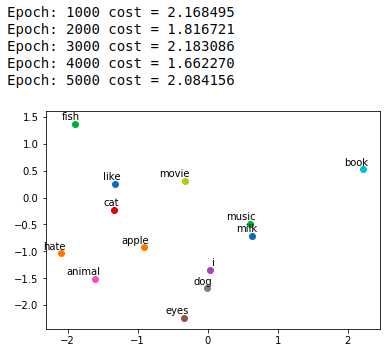标签:一起 offset lov 区别 windows rop tput 连续 联系
本文讲解 skip-gram 模型以及优化和扩展。主要包括层次 Softmax、负采样、学习短语的表示。
先提一下词向量:
介绍
该论文提出了几点优化扩展,比如对高频率词进行重采样,可以提高训练速度(大约 2倍 - 10倍),并且提高了低频词的向量表示。此外还提出了一种简化的噪声对比估计(Noise Contrastive Estimation, NCE),与之前使用层次 Softmax 相比,能够更快的训练和更好的表示频繁单词。
从基于单词的模型扩展到基于短语的模型相对简单,文中使用数据驱动的方法识别大量的短语,然后将短语作为单独的标记来处理。为了评估短语向量的质量,作者开发了一套包含单词和短语的类比推理任务测试集,效果如下:
vec(“Montreal Canadiens”) - vec(“Montreal”) + vec(“Toronto”) is vec(“Toronto Maple Leafs”)
vec(“Russia”) + vec(“river”) is close to vec(“Volga River”), and vec(“Germany”) + vec(“capital”) is close to vec(“Berlin”)
Skip-gram model

而Cbow模型是给定中心词 



本文使用霍夫曼二叉树来表示输出层,W 个词分别作为叶子节点,每个节点都表示其子节点的相对概率。总词汇中的每个词都有一条从二叉树根部到自身的路径。用 n(w,j) 来表示从根节点到 w 词这条路径上的第 j 个节点,用 ch(n) 来表示 n 的任意一个子节点,设如果 x 为真则[x]=1[x]=1,否则[x]=−1[x]=−1。那么 Hierarchical Softmax 可以表示为:

好处:
1.霍夫曼二叉树的节点离高频词距离更近,从而可以进行快速训练。之前已经观察到,通过频率将单词分组在一起,对于基于神经网络的语言模型来说,是一种非常简单的加速技术,效果很好。
2. 最多计算logW个节点
Noise Contrastive Estimation (NCE)-噪声对比估计,NCE表面,一个好的模型应该能够通过逻辑回归将数据与噪声区分开。
因为 skip-gram 更关注于学习高质量的词向量表达,所以可以在保证词向量质量的前提下对 NCE 进行简化。于是定义了 NEG(Negative Sampling):

实验表明,在5-20范围内k值对于小的训练数据集是有用的,而对于大数据集,k可以小到2-5。NCE 和 NEG 的区别在于 NCE 在计算时需要样本和噪音分布的数值概率,而 NEG 只需要样本。
为了克服稀有词和频繁词之间的不平衡,我们使用了一种简单的次抽样方法:训练集中的每个单词以公式计算的概率被丢弃。

其中,是单词
的频率,
是选择的阈值,通常在
左右。选择这个次抽样公式,是因为它在保持频率排序的同时,对频率大于t的词进行了积极的子采样。同时发现它在实践中效果很好。它加速了学习,甚至显着地提高了r的学习向量的准确性。

通过比较,作者们发现,似乎最好的短语表示是通过一个层次 softmax 和 Subsampling 结合的模型来学习的。
许多短语的含义并不是由单个单词的含义组成的。要学习短语的向量表示,首先要找到经常出现在一起的单词,并且组成一个 Token 作为一个词处理。通过这种方式,我们可以构成许多合理的短语,而不会大大增加词汇量;从理论上讲,我们可以使用所有n-gram训练Skip-gram模型,但这会占用大量内存。于是使用了一个基于 unigram, bigram 的数据驱动方法:

其中用作折扣系数,防止由非常不常用的单词组成的短语过多。然后将分数超过所选阈值的作为短语使用。这是用来评价性能的工具。
代码:来自https://github.com/graykode/nlp-tutorial/tree/master/1-2.Word2Vec
‘‘‘ code by Tae Hwan Jung(Jeff Jung) @graykode ‘‘‘ import numpy as np import torch import torch.nn as nn import torch.optim as optim from torch.autograd import Variable import matplotlib.pyplot as plt %matplotlib inline dtype = torch.FloatTensor # 定义一个多维张量torch # 3 Words Sentence sentences = [ "i like dog", "i like cat", "i like animal", "dog cat animal", "apple cat dog like", "dog fish milk like", "dog cat eyes like", "i like apple", "apple i hate", "apple i movie book music like", "cat dog hate", "cat dog like"] word_sequence = " ".join(sentences).split() word_list = " ".join(sentences).split() word_list = list(set(word_list)) #enumerate是一个枚举的关键词,i是键,w是值,这样就将所有单词按照自然数编成字典 word_dict = {w: i for i, w in enumerate(word_list)} # Word2Vec Parameter batch_size = 20 # To show 2 dim embedding graph embedding_size = 2 # To show 2 dim embedding graph voc_size = len(word_list) def random_batch(data, size): random_inputs = [] random_labels = [] # 随机选取sample random_index = np.random.choice(range(len(data)), size, replace=False) for i in random_index: random_inputs.append(np.eye(voc_size)[data[i][0]]) # target random_labels.append(data[i][1]) # context word return random_inputs, random_labels # Make skip gram of one size window #构建输入的samples skip_grams = [] for i in range(1, len(word_sequence) - 1): target = word_dict[word_sequence[i]] context = [word_dict[word_sequence[i - 1]], word_dict[word_sequence[i + 1]]] for w in context: skip_grams.append([target, w]) # Model class Word2Vec(nn.Module): def __init__(self): super(Word2Vec, self).__init__() # W and WT is not Traspose relationship # 初始化从输入到隐藏层的嵌入矩阵,参数随机初始化在(-1,1] self.W = nn.Parameter(-2 * torch.rand(voc_size, embedding_size) + 1).type(dtype) # voc_size > embedding_size Weight # 随机初始化从隐藏层到输出层的系数矩阵,参数随机初始化在(-1,1] self.WT = nn.Parameter(-2 * torch.rand(embedding_size, voc_size) + 1).type(dtype) # embedding_size > voc_size Weight # 前向传播 def forward(self, X): # X : [batch_size, voc_size] hidden_layer = torch.matmul(X, self.W) # hidden_layer : [batch_size, embedding_size] output_layer = torch.matmul(hidden_layer, self.WT) # output_layer : [batch_size, voc_size] return output_layer model = Word2Vec() # 定义损失函数和优化 criterion = nn.CrossEntropyLoss() optimizer = optim.Adam(model.parameters(), lr=0.001) # Training for epoch in range(5000): input_batch, target_batch = random_batch(skip_grams, batch_size) # 被定义为Varialbe类型的变量可以认为是一种常量,在pytorch反向传播过程中不对其求导 input_batch = Variable(torch.Tensor(input_batch)) target_batch = Variable(torch.LongTensor(target_batch)) optimizer.zero_grad() output = model(input_batch) # output : [batch_size, voc_size], target_batch : [batch_size] (LongTensor, not one-hot) loss = criterion(output, target_batch) if (epoch + 1)%1000 == 0: print(‘Epoch:‘, ‘%04d‘ % (epoch + 1), ‘cost =‘, ‘{:.6f}‘.format(loss)) loss.backward() optimizer.step() for i, label in enumerate(word_list): # model.parameters()是获取模型的参数 W, WT = model.parameters() x, y = float(W[i][0]), float(W[i][1]) plt.scatter(x, y) plt.annotate(label, xy=(x, y), xytext=(5, 2), textcoords=‘offset points‘, ha=‘right‘, va=‘bottom‘) plt.show()
结果:

Distributed Representations of Words and Phrases and their Compositionality论文阅读及实战
标签:一起 offset lov 区别 windows rop tput 连续 联系
原文地址:https://www.cnblogs.com/harbin-ho/p/12810977.html